By Eric Vandenbroeck
On 16 Sept. 2019 following an attack on Saudi Arabia from Yemen I
suggested that: Reason dictates that the Trump administration should not
join the Saudi-Iran proxy war, or attack Iran on Riyadh’s behalf. Instead,
Washington should leverage the attacks on Saudi Arabia’s oil infrastructure
that have caused an unprecedented outage to push for a resolution to the
disastrous war in Yemen.
What happened also is
that the Trump Administration’s mixed signals on Syria, last-minute decision to
abort a retaliatory strike for Iran’s downing of an American drone, have
dissipated the earlier deterrent effect of President Trump’s warnings to Iran. Iran
does not doubt U.S. military capabilities—but has reason to question
Washington’s willingness to use them. That is why I wrote on 27 Dec. that now
the odds of a U.S. military response either directly against Iran or against
the militias in Iraq backed by Tehran have risen following the 27 Dec. rocket attack on a military base in Kirkuk.
The response came in fact the very next day:
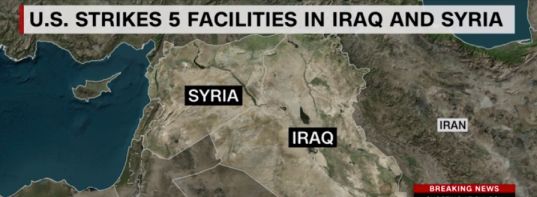
The contractor's death marked the first U.S. casualty in
2019 as a result of an Iranian-linked PMU attack in Iraq or Syria.
Likewise, the US strikes on 5 Iraq backed facilities in Iraq and Syria caused
the deaths of dozens of Kataib Hezbollah members marked a significant
escalation.
Protesters
attacked the US Embassy in Baghdad today, scaling the walls and forcing the
gates of the compound, as hundreds demonstrated against American
airstrikes on an Iran-backed militia group in Iraq.
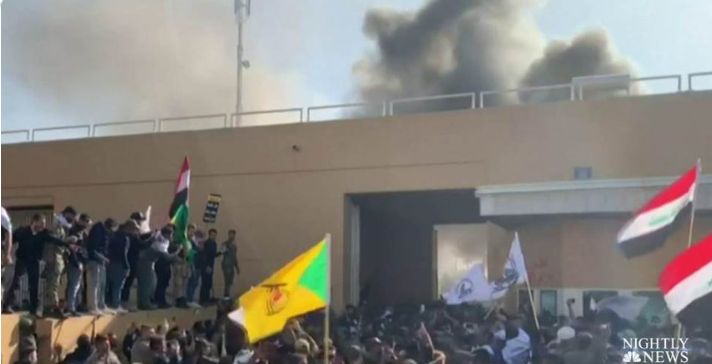
AH-64 Apaches were deployed to protect the US Embassy in Baghdad.
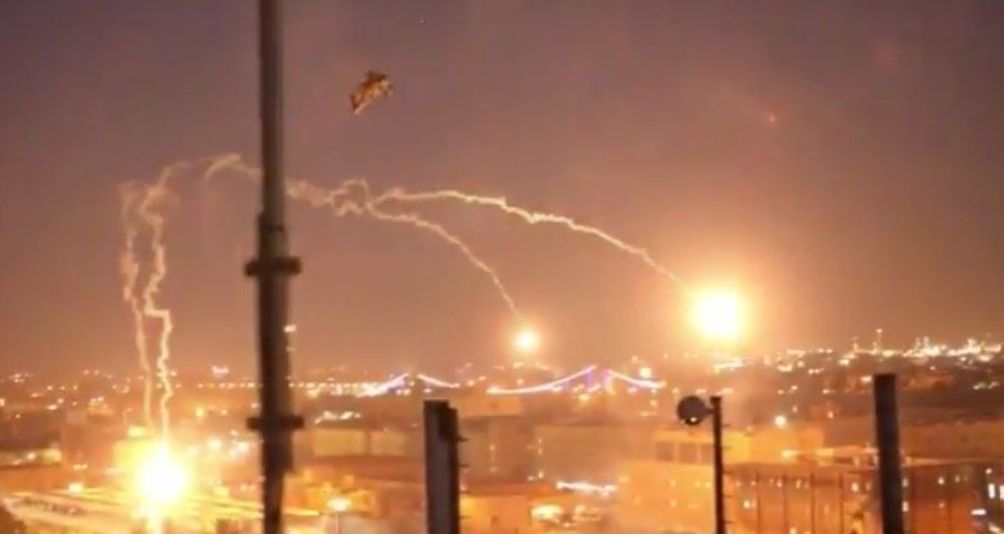
As night fell,
protestors set up tents near the embassy, suggesting another day of upheaval
lies ahead. Iraqi counterterrorism forces were deployed around the perimeter of
the embassy, while the Pentagon announced additional Marines would be sent to
Baghdad and more troops would be deployed to the Middle East in response to the
embassy crisis.
US secretary of State
Pompeo worked the phones Tuesday, speaking with Iraq’s prime minister and
president. According to a State Department spokeswoman, Pompeo “made clear the
United States will protect and defend its people,” and the Iraqi leaders said they
“took seriously their responsibility” to ensure the safety of the U.S. Embassy.
Sen. Lindsey Graham
made the connection between Benghazi and Baghdad in a tweet after meeting with
President Donald Trump on Tuesday. “President Trump is determined to protect
American personnel and expects our Iraqi partners to step up to the plate. No more
Benghazis,” Graham tweeted.
“Very reassuring to see President Trump has beefed up our military capability
to protect our personnel in Baghdad.”
Whereby Trump said
that he does not want, or foresee, war with Iran after
he earlier threatened to retaliate against the country.
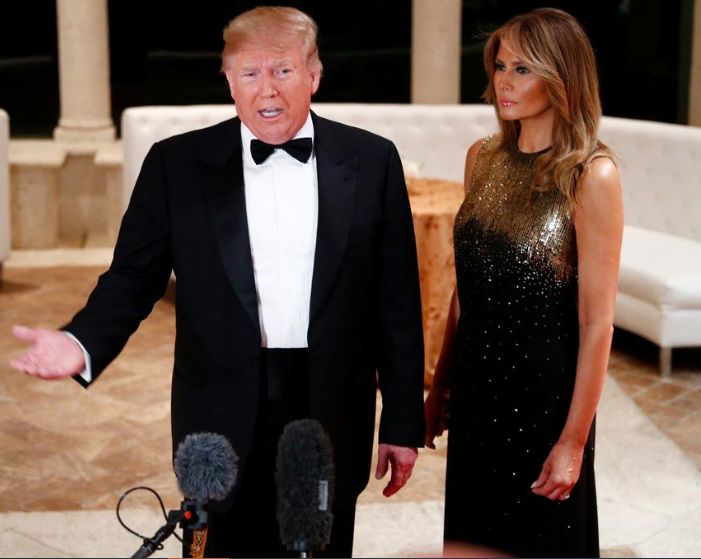
Some like the British
Guardian, however, suggested that the Iraq
riots expose America weaker and with fewer options. "And that no one –
almost certainly not even Trump – knows how he is going to respond." As I
will explain next what it might indeed do is lead to a growing tolerance for
risk from the side of Iran.
In fact Iran’s
leaders seem not likely to be deterred by US President Donald Trump’s warning
on 31 Dec. that Tehran would be held
responsible for attacks on US forces in Iraq and the storming of the US embassy
in Baghdad. The mob of thousands of Kataib Hezballah
supporters who broke into the embassy on Tuesday heralded the reverse scenario.
Iran believes that ramping up the pressure on US forces in Iraq will serve its
interests in Iraq as well as in Syria.
What next?
Iran's extensive
links with militia groups in both Syria and Iraq provide Tehran with a means by
which to strike at U.S. forces by proxy. Given its larger dispute with
Washington amid the U.S. sanctions campaign that has stifled its economy, Iran
has become increasingly willing to use that option. But as the U.S.
counterstrike illustrates, a proxy attack still carries with it the real
possibility of a further escalation of attacks and counterattacks by both
sides. Immediately after the airstrikes, the United States asserted that they
were a direct retaliation over the attack on K-1, characterizing them as an
effort to deter future militia operations against its forces. This fits in with
Washington's preferred strategy of leaning heavily on sanctions, including
those put in place in December against Iraqi militia leaders, to cripple Iran
while seeking to avoid a military escalation to full war.
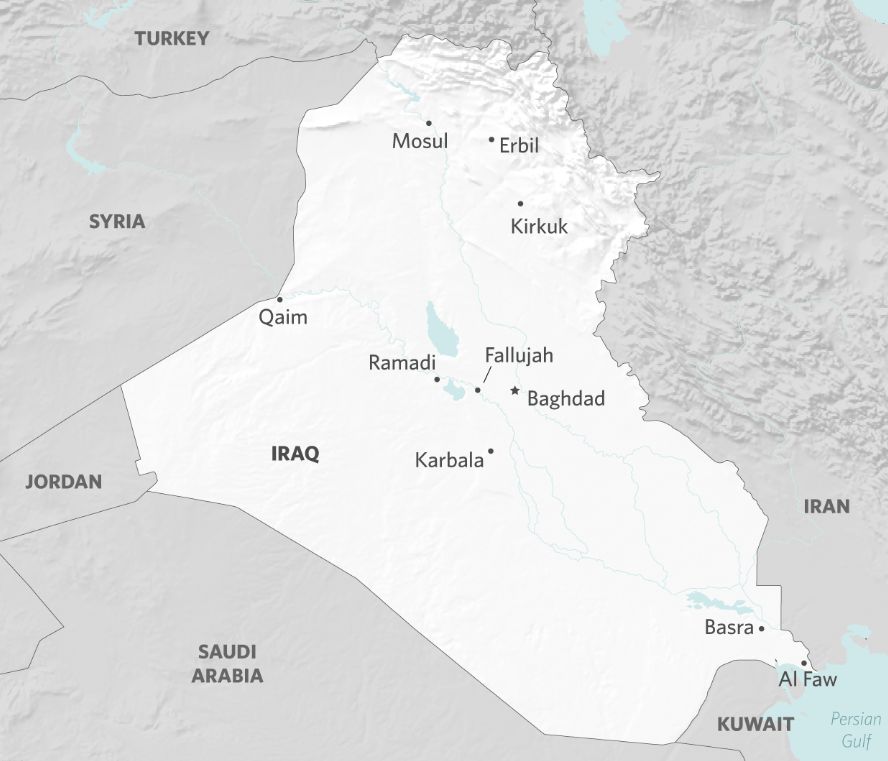
The United States is
also aware that, given the operating environment in Iraq and Syria, its forces
dispersed in the two countries are vulnerable to attacks from Iranian-linked
militias. For its part, Iran is cognizant of the risks that military escalation
with a country as powerful as the United States carries. Still, pressure from
the economic sanctions has left Tehran more willing to absorb those risks as it
seeks ways to push back.
Beyond risking a
fight with the United States that could spread to Iran itself, an escalation of
violence at a time when Iraqi street protesters are decrying the Iranian
influence in their country could also backfire on Tehran. But even with those
risks hanging over their heads, Iran's deteriorating economy and the eagerness
of some of its PMU proxies to confront U.S. forces could tempt Iranian leaders
to act. Even if a large-scale Iranian counterattack over the U.S. strike on
Kataib Hezbollah does not materialize, the rocket attacks on U.S. positions in
Iraq and Syria are not only likely to continue, and they may even increase in
intensity.
Iranian proxies could
also use other means of attack, such as with improvised explosive devices. This
means that there is a continued high likelihood of further U.S. casualties at
the hands of Iranian-linked militias. Those, in turn, could lead to new rounds
of U.S. strikes. At this stage in their confrontation, a rapid escalation of
violence between Iran and the United States is hardly inevitable. However, the
potential for more incidents will remain elevated as long as the political
acrimony between the countries remains in its current state.
The Iraqi Government's Dilemma
The violent exchanges
further complicate the already chaotic political
situation in Baghdad and will strain Iraq's relationship with both Iran and
the United States. Many Iraqi PMUs have been directly funded and equipped by
Iran, and thus are accurately viewed by Washington as direct tools of Iran. But
the fact that the militias comprise Iraqi fighters gives Iran a degree of
political protection from the Iraqi government over their continued use in
Iraq, as well as some plausible deniability as it uses the militias to bolster
regional hegemony.
Iraqi politicians who
have ties with both the United States and Iran have issued measured
condemnations of the airstrikes, but have stopped short of calling for the
withdrawal of U.S. forces. This underscores their desire not to antagonize
either country, both of which are powerful security backers and necessary
economic partners for Baghdad. On Dec. 29, for example, Iraqi President Barham
Salih called the U.S. airstrike unacceptable, and the same day, the dominant
Dawa party issued a statement condemning the use of Iraq as a site for the
United States and Iran to settle scores. The Iraqi prime minister's office,
which had been informed that the airstrikes would occur about half an hour
before they happened, said it "strongly rejected" the actions.
Meanwhile, leaders of Iraq's Iranian-allied PMUs, including commander Abu Mahdi
al-Muhandis, called for U.S. forces to withdraw from
Iraq. He also threatened further retaliation, a threat that carries
considerable weight.
Beyond the
condemnations, the Iraqi government's lack of control over U.S. or Iranian
actions in Iraq opens the likelihood of some diplomatic deterioration between
Washington and Baghdad. Given that the fighters among the PMU's ranks are
Iraqi, Baghdad will be forced to distance itself publicly from direct
cooperation with future U.S. actions against them, and even despite Baghdad's
own (mostly failed) efforts over the years to rein in some of the aggressive
actions by the PMUs. A strategic framework agreement between Iraq and the
United States facilitates close coordination between Iraqi security forces and
the estimated 5,000 U.S. troops in the country.
While it has proved
valuable in increasing Iraqi security, the agreement has come under increasing
political pressure from Iranian-allied politicians in parliament who want U.S.
forces to leave Iraq. Iraq's security council said on Dec. 30 it would "reconsider"
the relationship between Iraq and the U.S.-led coalition fighting the Islamic
State, reflecting Baghdad's tricky position.
The airstrikes will
add fuel to the ongoing debate, even though the Iran-allied PMUs themselves
remain unpopular among many Iraqis because of their penchant for quasi-legal
violence and because their presence makes Iraq a vulnerable proxy theater. A
further factor in Baghdad's political decision-making will hinge on the
reaction by Iraq's protest movement, especially if demonstrators demand that
U.S. operations in Iraq be reined in. Given the limits of Iraq's current
caretaker government to respond to emboldened demonstrators, the re-evaluation
of the strategic framework agreement that has been stalled in parliament will
accelerate if Iraqi protesters demand it.
Moving forward, Iraq
will remain a highly volatile site of confrontation between the United States
and Iran, damaging Iraq’s diplomatic relations with both countries. But the
ball is currently in Iran's court, and the extent of the response by Iranian-linked
militias to the U.S. airstrikes will determine whether a cycle of escalation
takes hold in Iraq.
From Iran’s point of
view, violence may seem like the best or only way to send a message. Iran
hereby wants to increase the costs to the U.S. of its maximum pressure
strategy. And as we have seen Iraq and Syria are the proxy theaters where both
countries have forces and where Iran will try to rebalance the power equation
in its favor.
That means there will
be more escalation.
For updates click homepage here